Whether a technology initiative succeeds or not depends on more than the technology itself. Human factors have a big influence on the results as well.
Recognizing this, Esri has created a people-focused change management practice. Certified change management consultants work side by side with users to secure executive sponsorship, engage all organizational stakeholders, and craft effective strategies to ensure that those who are impacted by technological change have the information and tools they need to smoothly transition to new workflows.
Esri spent two months last year collecting input from organizational and GIS staff members who had been involved in recent ArcGIS implementation projects. The purpose of the 2020 Esri Change Management Survey was to assess the “state of people-focused change management.” In other words, Do organizations know what people-focused change management is? Are they using it? If so, has it made a difference? (The survey did not ask about usage or awareness of Esri’s change management practice. Rather, it centered on people-focused change management in general.)
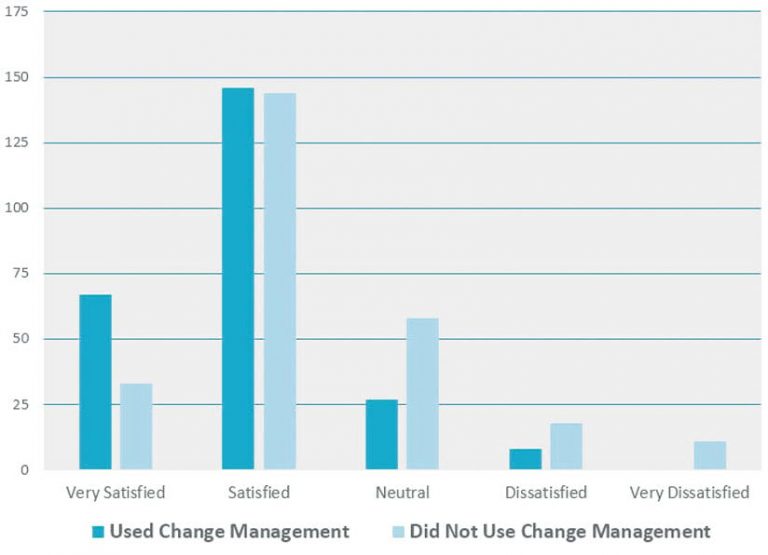
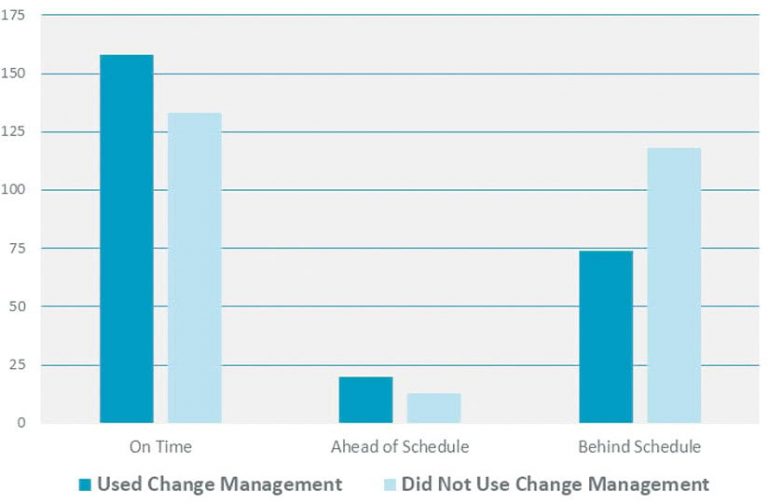
More than 500 people from public and private sector organizations around the United States participated in the survey, and Esri found that usage of people-focused change management was split almost evenly among them. Fifty-one percent of respondents had projects that did not include a change management aspect, while 49 percent had projects that did. The scale of implementations ranged from a single department to the entire organization.
Results of the survey were clear: including people-focused change management in an ArcGIS implementation project offers significant benefits.
Whether or Not a Project Will Achieve Its Business Goals
As with any business investment, technology should deliver advantages that outweigh the costs.
Eighty-nine percent of survey participants who employed people-focused change management in conjunction with their ArcGIS implementation projects were satisfied or very satisfied that the projects had achieved or would attain their business goals. By contrast, only 67 percent of the participants who did not use change management reported being satisfied or very satisfied that their projects had done or would do that. And only about half of this latter group—55 percent—said that their projects finished on time or ahead of schedule.
Tellingly, participants who used change management were more than twice as likely to be very satisfied that their projects would achieve their business goals than participants who did not use change management (27 percent versus 12.5 percent). Furthermore, no participants who employed change management were very dissatisfied with this aspect of their projects, whereas 4 percent of those on the other end of the spectrum were very dissatisfied with their outcomes.
The Speed, Scope, and Proficiency of Adoption
While project teams can take a build-it-and-they-will-come approach to deploying new technology, they do so at the risk of low adoption rates. Results from the survey shed light on how including people-focused change management impacts key metrics related to adoption.
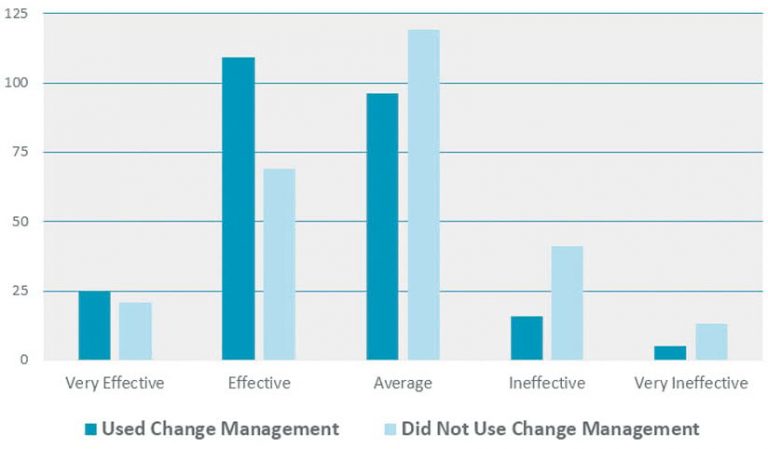
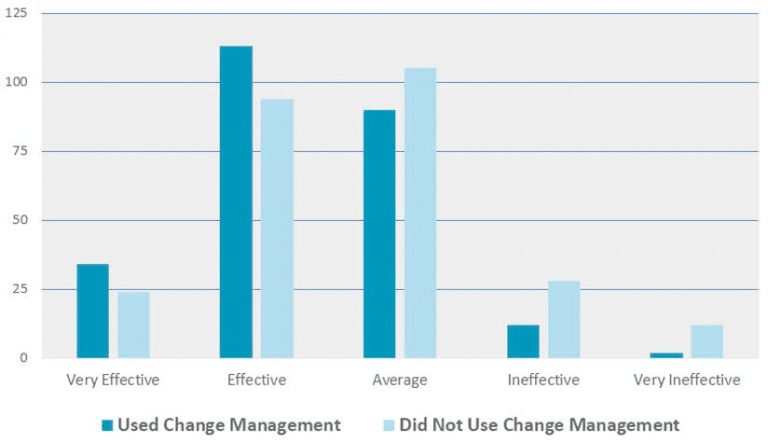
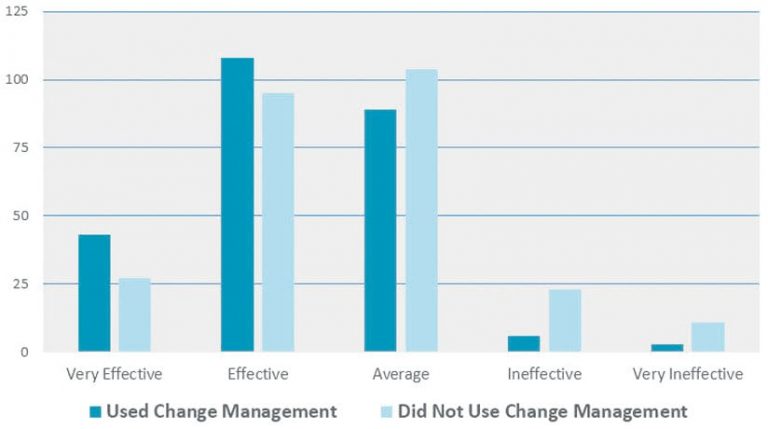
Survey participants were asked to rate how their change management projects affected the speed of technology adoption, the number of users who started using it, and their proficiency with the new technology. Once again, the responses reveal disparate outcomes between the two groups.
Regarding the speed of adoption, more than half (53 percent) of participants whose projects embraced people-focused change management said their project was effective or very effective at getting users to quickly adopt the new technology. Only about a third (34 percent) of participants whose projects lacked a change management aspect attained speedy adoption rates.
When rating the impact their projects had on the number of users employing the new technology after it was implemented, the two groups differed by 14 percent. Fifty-nine percent of participants who used change management chose the effective or very effective rating versus 45 percent of participants who didn’t employ change management. Interestingly, 15 percent of participants who didn’t use change management rated their project’s impact on the number of users as ineffective or very ineffective, whereas less than 6 percent of those who did employ change management chose either of those ratings.
User proficiency with the new technology can be an indicator of long-term adoption. Sixty percent of participants who employed change management rated their project’s impact on user proficiency as effective or very effective compared to 47 percent of those who did not use change management. In addition, more than three times as many participants who did not use change management rated their project’s impact on user proficiency as ineffective or very ineffective. compared to participants who did engage in people-focused change management (13 percent versus 3.6 percent).
Finally, survey participants who did not engage in change management were asked if they thought that including a people-focused change management plan would have increased users’ adoption of the technology they implemented. More than half—59 percent—of them said yes.
It is clear that not heeding the people side of technology can have, at worst, undesirable consequences and, at best, fewer desirable results.
A Change Management Approach Has Demonstrated Importance
When implementing technology to improve operations, gain insight, and produce better products and services, humans certainly play a vital role in ensuring that technology’s success. The results from the 2020 Esri Change Management Survey reinforce the importance of engaging and supporting the workforce before, during, and after new technology implementations.
Simultaneously deploying ArcGIS and a people-focused change management plan helps organizations achieve faster adoption rates and a higher number of users working with greater proficiency. Most importantly, people-focused change management helps organizations achieve the business values they set out to attain by making a technological investment.
Learn more about people-focused change management and Esri’s change management practice.

